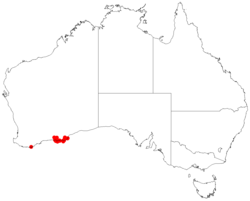Biology:Leucopogon rotundifolius
| Leucopogon rotundifolius | |
|---|---|
| Scientific classification | |
| Kingdom: | Plantae |
| Clade: | Tracheophytes |
| Clade: | Angiosperms |
| Clade: | Eudicots |
| Clade: | Asterids |
| Order: | Ericales |
| Family: | Ericaceae |
| Genus: | Leucopogon |
| Species: | L. rotundifolius
|
| Binomial name | |
| Leucopogon rotundifolius R.Br.[1]
| |

| |
| Occurrence data from AVH | |
| Synonyms[1] | |
| |
Leucopogon rotundifolius is a species of flowering plant in the heath family Ericaceae and is endemic to the south of Western Australia. It is an erect, bushy shrub with round or egg-shaped leaves, the narrower end towards the base, and white, tube-shaped flowers arranged in leaf axils in groups of 2 or 3.
Description
Leucopogon rotundifolius is an erect, bushy shrub that has erect or spreading, round to egg-shaped leaves with the narrower end towards the base, 6.3–8.5 mm (0.25–0.33 in) long on a short petiole. The base of the leaves is heart-shaped and there is often a small hard point on the tip. The flowers are borne in leaf axils in groups of 2 or 3 with tiny bracts, and bracteoles that are about half as long as the sepals. The sepals are 2.0–2.6 mm (0.079–0.102 in) long, the petals white, about 6.3 mm (0.25 in) long and joined at the base, the lobes about the same length as the petal tube.[2]
Taxonomy
Leucopogon rotundifolius was first formally described in 1810 by Robert Brown in his Prodromus Florae Novae Hollandiae et Insulae Van Diemen.[3][4] The specific epithet (rotundifolius) means "round-leaved".[5]
Distribution and habitat
This leucopogon in the Esperance Plains and Mallee bioregions of south-western Western Australia.[6]
Conservation status
Leucopogon rotundifolius is listed (as Styphelia rotundifolia) as "Priority Three" by the Government of Western Australia Department of Biodiversity, Conservation and Attractions,[6] meaning that it is poorly known and known from only a few locations, but is not under imminent threat.[7]
References
- ↑ 1.0 1.1 "Leucopogon rotundifolius". https://biodiversity.org.au/nsl/services/apc-format/display/67627. Retrieved 5 May 2023.
- ↑ Bentham, George; von Mueller, Ferdinand (1868). Flora Australiensis. 4. London: Lovell Reeve & Co.. p. 214. https://www.biodiversitylibrary.org/page/11266435#page/223/mode/1up. Retrieved 5 May 2023.
- ↑ "Leucopogon rotundifolius". APNI. https://id.biodiversity.org.au/instance/apni/476114.
- ↑ Brown, Robert (1810). Prodromus Florae Novae Hollandiae et Insulae Van Diemen. London. p. 546. https://www.biodiversitylibrary.org/item/21871#page/414/mode/1up. Retrieved 5 May 2023.
- ↑ Sharr, Francis Aubi; George, Alex (2019). Western Australian Plant Names and Their Meanings (3rd ed.). Kardinya, WA: Four Gables Press. p. 297. ISBN 9780958034180.
- ↑ 6.0 6.1 "Styphelia rotundifolia". FloraBase. Western Australian Government Department of Parks and Wildlife. https://florabase.dpaw.wa.gov.au/browse/profile/49824.
- ↑ "Conservation codes for Western Australian Flora and Fauna". Government of Western Australia Department of Parks and Wildlife. https://www.dpaw.wa.gov.au/images/documents/plants-animals/threatened-species/Listings/Conservation%20code%20definitions.pdf. Retrieved 5 May 2023.
Wikidata ☰ Q17241252 entry
 |


